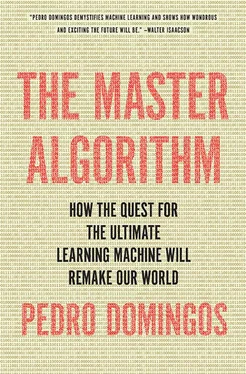
However, that doesn’t mean their chemical behavior is similar. Methane is a gas, while methanol is an alcohol. The second part of analogical reasoning is figuring out what we can infer about the new object based on similar ones we’ve found. This can be very simple or very complex. In nearest-neighbor or SVMs, it just consists of predicting the new object’s class based on the classes of the nearest neighbors or support vectors. But in case-based reasoning, another type of analogical learning, the output can be a complex structure formed by composing parts of the retrieved objects. Suppose your HP printer is spewing out gibberish, and you call up their help desk. Chances are they’ve seen your problem many times before, so a good strategy is to find those records and piece together a potential solution for your problem from them. This is not just a matter of finding complaints with many similar attributes to yours: for example, whether you’re using your printer with Windows or Mac OS X may cause very different settings of the system and the printer to become relevant. And once you’ve found the most relevant cases, the sequence of steps needed to solve your problem may be a combination of steps from different cases, with some further tweaks specific to yours.
Help desks are currently the most popular application of case-based reasoning. Most still employ a human intermediary, but IPsoft’s Eliza talks directly to the customer. Eliza, who comes complete with a 3-D interactive video persona, has solved over twenty million customer problems to date, mostly for blue-chip US companies. “Greetings from Robotistan, outsourcing’s cheapest new destination,” is how an outsourcing blog recently put it. And, just as outsourcing keeps climbing the skills ladder, so does analogical learning. The first robo-lawyers that argue for a particular verdict based on precedents have already been built. One such system correctly predicted the outcomes of over 90 percent of the trade secret cases it examined. Perhaps in a future cyber-court, in session somewhere on Amazon’s cloud, a robo-lawyer will beat the speeding ticket that RoboCop issued to your driverless car, all while you go to the beach, and Leibniz’s dream of reducing all argument to calculation will finally have come true.
Arguably even higher up in the skills ladder is music composition. David Cope, an emeritus professor of music at the University of California, Santa Cruz, designed an algorithm that creates new music in the style of famous composers by selecting and recombining short passages from their work. At a conference I attended some years ago, he played three “Mozart” pieces: one by the real Mozart, one by a human composer imitating Mozart, and one by his system. He then asked the audience to vote for the authentic Amadeus. Wolfgang won, but the computer beat the human imitator. This being an AI conference, the audience was delighted. Audiences at other events were less happy. One listener angrily accused Cope of ruining music for him. If Cope is right, creativity-the ultimate unfathomable-boils down to analogy and recombination. Judge for yourself by googling “david cope mp3.”
Analogizers’ neatest trick, however, is learning across problem domains. Humans do it all the time: an executive can move from, say, a media company to a consumer-products one without starting from scratch because many of the same management skills still apply. Wall Street hires lots of physicists because physical and financial problems, although superficially very different, often have a similar mathematical structure. Yet all the learners we’ve seen so far would fall flat if we, say, trained them to predict Brownian motion and then asked them to predict the stock market. Stock prices and the velocities of particles suspended in a fluid are just different variables, so the learner wouldn’t even know where to start. But analogizers can do this using structure mapping, an algorithm invented by Dedre Gentner, a psychologist at Northwestern University. Structure mapping takes two descriptions, finds a coherent correspondence between some of their parts and relations, and then, based on that correspondence, transfers further properties from one structure to the other. For example, if the structures are the solar system and the atom, we can map planets to electrons and the sun to the nucleus and conclude, as Bohr did, that electrons revolve around the nucleus. The truth is more subtle, of course, and we often need to refine analogies after we make them. But being able to learn from a single example like this is surely a key attribute of a universal learner. When we’re confronted with a new type of cancer-and that happens all the time because cancers keep mutating-the models we’ve learned for previous ones don’t apply. Neither do we have time to gather data on the new cancer from a lot of patients; there may be only one, and she urgently needs a cure. Our best hope is then to compare the new cancer with known ones and try to find one whose behavior is similar enough that some of the same lines of attack will work.
Is there anything analogy can’t do? Not according to Douglas Hofstadter, cognitive scientist and author of Gödel, Escher, Bach: An Eternal Golden Braid . Hofstadter, who looks a bit like the Grinch’s good twin, is probably the world’s best-known analogizer. In their book Surfaces and Essences: Analogy as the Fuel and Fire of Thinking , Hofstadter and his collaborator Emmanuel Sander argue passionately that all intelligent behavior reduces to analogy. Everything we learn or discover, from the meaning of everyday words like mother and play to the brilliant insights of geniuses like Albert Einstein and Évariste Galois, is the result of analogy in action. When little Tim sees women looking after other children like his mother looks after him, he generalizes the concept “mommy” to mean anyone’s mommy, not just his. That in turn is a springboard for understanding things like “mother ship” and “Mother Nature.” Einstein’s “happiest thought,” out of which grew the general theory of relativity, was an analogy between gravity and acceleration: if you’re in an elevator, you can’t tell whether your weight is due to one or the other because their effects are the same. We swim in a vast ocean of analogies, which we both manipulate for our ends and are unwittingly manipulated by. Books have analogies on every page (like the title of this section, or the previous one’s). Gödel, Escher, Bach is an extended analogy between Gödel’s theorem, Escher’s art, and Bach’s music. If the Master Algorithm is not analogy, it must surely be something like it.
Rise and shine
Cognitive science has seen a long-running debate between symbolists and analogizers. Symbolists point to something they can model that analogizers can’t; then analogizers figure out how to do it, come up with something they can model that symbolists can’t, and the cycle repeats. Instance-based learning, as it’s sometimes called, is supposedly better for modeling how we remember specific episodes in our lives; rules are the putative choice for reasoning with abstract concepts like “work” and “love.” But when I was a graduate student, it struck me that these two are really just points on a continuum, and we should be able to learn across all of it. Rules are in effect generalized instances where we’ve “forgotten” some attributes because they didn’t matter. Conversely, instances are very specific rules, with a condition on every attribute. As we go through life, similar episodes gradually become abstracted into rule-based structures, like “eating at a restaurant.” You know that going to a restaurant involves ordering from a menu and leaving a tip, and you follow those “rules of conduct” every time you eat out, but you probably don’t remember the specific restaurants where you first became aware of them.
Читать дальше













